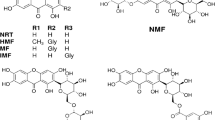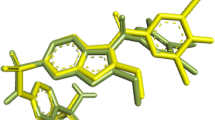Abstract
Diabetes mellitus continues to be a major health concern for the global population. Targeting visfatin has been identified as a possible channel to manage the disease effectively. Kuguacins are triterpenoids with established antidiabetic activity. Therefore, this study examines the visfatin activating potentials of kuguacins using molecular docking, density functional theory (DFT), molecular dynamics (MD) simulation, ADMET and drug-likeness methods. The DFT studies employed B3LYP/6+3G (d, p) basis set to calculate the electronic parameters while MD simulation was performed for 100 ns. ADMET online server was used to determine their drug-likeness and pharmacokinetic properties. Kuguacin I (−11.3 kcal/mol), kuguacin F (−10.8 kcal/mol), kuguacin R (−10.8 kcal/mol) and kuguacin M (−10.2 kcal/mol) were identified as the top-ranked molecules. The quantum chemical properties of the hit molecules suggest them as suitable visfatin activators. The RMSD and RMSF plots showed that the top-ranked kuguacins were stable and suitable as visfatin activators. Also, the MMGBSA binding free energy of the ligands ranged between −43.99 kcal/mol and −34.94 kcal/mol. The ADMET and drug-likeness properties reveal the top-ranked molecules as suitable drug candidates. The findings from this study can be verified in vitro and in vivo.








Similar content being viewed by others
Data availability
Data is available in this article and supplementary material.
References
Soumya D, Srilatha B (2011) Late stage complications of diabetes and insulin resistance. J Diabetes Metab 2(9):1000167
Thomas MC, Cooper ME, Zimmet P (2016) Changing epidemiology of type 2 diabetes mellitus and associated chronic kidney disease. Nat Rev Nephrol 12(2):73–81
Galicia-Garcia U, Benito-Vicente A, Jebari S, Larrea-Sebal A, Siddiqi H, Uribe KB, Ostolaza H, Martín C (2020) Pathophysiology of type 2 diabetes mellitus. Int J Mol Sci 21(17):6275
Di Raimo T, Azzara G, Corsi M, Cipollone D, Lo Vasco VR, Businaro R (2015) Adipokines and their involvement as a target of new drugs. J Pharmacovigil 3:2–10
Kyrou I, Mattu HS, Chatha K, Randeva HS (2017) Fat hormones, adipokines. In: Endocrinology of the Heart in health and disease. Academic Press, Cambridge, pp. 167–205
Adeghate E (2008) Visfatin: structure, function and relation to diabetes mellitus and other dysfunctions. Curr Med Chem 15(18):1851–1862
Elekofehinti OO, Ejelonu OC, Kamdem JP, Akinlosotu OB, Famuti A, Adebowale DD, Iwaloye O, Bulu YI, Kade IJ, Rocha JBT (2018) Discovery of potential visfatin activators using in silico docking and ADME predictions as therapy for type 2 diabetes. Beni-Suef Univ J Basic Appl Sci.
Elujoba AA, Odeleye OM, Ogunyemi CM (2005) Traditional medicine development for medical and dental primary health care delivery system in Africa. Afr J Tradit Complement Altern Med 2(1):46–61
Chen J, Tian R, Qiu M, Lu L, Zheng Y, Zhang Z (2008) Trinorcucurbitane and cucurbitane triterpenoids fromthe roots of Momordica charantia. Phytochemistry 69(4):1043–1048
Chen JC, Liu WQ, Lu L, Qiu MH, Zheng YT, Yang LM, Zhang XM, Zhou L, Li ZR (2009) Kuguacins F-S, cucurbitane triterpenoids from Momordica charantia. Phytochemistry 70(1):133–140
Ramalhete C, Mulhovo S, Lage H, Ferreira MJU (2018) Triterpenoids from Momordica balsamina with a collateral sensitivity effect for tackling multidrug resistance in cancer cells. Planta Med 84(18):1372–1379
Chen JC, Bik-San Lau B, Chan JYW, Fung KP, Leung PC, Liu JQ, Zhou L, Xie MJ, Qiu MH (2015) The antigluconeogenic activity of cucurbitacins from Momordica charantia. Planta Med 81(04):327–332
Elekofehinti OO, Ariyo EO, Akinjiyan MO, Olayeriju OS, Lawal AO, Adanlawo IG, Rocha JBT (2018) Potential use of bitter melon (Momordica charantia) derived compounds as antidiabetics: in silico and in vivo studies. Pathophysiology 25(4):327–333
Hsing HY, Rathnasamy S, Dianita R, Wahab HA (2020) Docking based virtual screening in search for natural PTP1B inhibitors in treating type-2 diabetes mellitus and obesity. Biomed Res Ther 7(1):3579–3592
Pitchakarn P, Umsumarng S, Mapoung S, Ting P, Temviriyanukul P, Punfa W, Pompimon W, Limtrakul P (2017) Kuguacin J isolated from bitter melon leaves modulates paclitaxel sensitivity in drug-resistant human ovarian cancer cells. J Nat Med 71(4):693–702
Prachayasittikul V, Worachartcheewan A, Shoombuatong W, Songtawee N, Simeon S, Prachayasittikul V, Nantasenamat C (2015) Computer-aided drug design of bioactive natural products. Curr Top Med Chem 15(18):1780–1800
Baldi A (2010) Computational approaches for drug design and discovery: an overview. Syst Rev Pharm 1:99
Palermo G, De Vivo M (2014) Computational chemistry for drug discovery. Encycl Nanotechnol 66:334–395
Sethi A, Joshi K, Sasikala K, Alvala M (2019) Molecular docking in modern drug discovery: principles and recent applications. Drug Discov. Dev. New Adv, 27–39.
Ferreira LG, Dos Santos RN, Oliva G, Andricopulo AD (2015) Molecular docking and structure-based drug design strategies. Molecules 20:13384–13421
Marinho MM, Almeida-Neto FWQ, Marinho EM, da Silva LP, Menezes RR, Dos Santos RP, Marinho ES, de Lima-Neto P, Martins AM (2021) Quantum computational investigations and molecular docking studies on amentoflavone. Heliyon 7(1):e06079
Trott O, Olson AJ (2010) AutoDock Vina: improving the speed and accuracy of docking with a new scoring function, efficient optimisation, and multithreading. J Comput Chem 31:455–461
Huang C, Li C, Choi PY, Nandakumar K, Kostiuk LW (2011) A novel method for molecular dynamics simulation in the isothermal–isobaric ensemble. Mol Phys 109(2):191–202
Ahmad S, Pasha KM, Raza K, Rafeeq MM, Habib AH, Eswaran M, Yadav MK (2022) Reporting dinaciclib and theodrenaline as a multitargeted inhibitor against SARS-CoV-2: an in-silico study. J Biomol Struct Dyn 2022:1–11
Becke AD (1993) A new mixing of HartreeeFock and local density-functional theories. J Chem Phys 98:1372–1377
Lipinski C, Lombardo F, Dominy BW, Feeney PJ (2001) Experimental and computational approaches to estimate solubility and permeability in drug discovery and development settings. Adv Drug Deliv Rev 23:3–25
Olawale F, Iwaloye O, Elekofehinti OO (2021) Virtual screening of natural compounds as selective inhibitors of polo-like kinase-1 at C-terminal polo box and N-terminal catalytic domain. J Biomol Struct Dyn, 1–19
Sathish Sekar D, Sivagnanam K, Subramanian S (2005) Antidiabetic activity of Momordica charantia seeds on streptozotocin induced diabetic rats. Die Pharmazie-An International Journal of Pharmaceutical Sciences 60(5):383–387
Joseph B, Jini D (2013) Antidiabetic effects of Momordica charantia (bitter melon) and its medicinal potency. Asian Pac J Trop Dis 3(2):93–102
Parra AL, Soto-del Valle RM, Ferrer JP, Hang PTN, Thi N, Phuong AB, López OD, Guarnaluce DC, Ferrada CR, Alejandro S, Yaquis P (2021) Antidiabetic, hypolipidemic, antioxidant and anti-inflammatory effects of Momordica charantia L. foliage extract. J Pharm Pharm Res 9(4):537–548.
Rehman S, Ali Ashfaq U, Sufyan M, Shahid I, Ijaz B, Hussain M (2022) The Insight of In Silico and In Vitro evaluation of Beta vulgaris phytochemicals against Alzheimer’s disease targeting acetylcholinesterase. PLoS ONE 17(3):e0264074
Faloye KO, Bekono BD, Fakola EG, Ayoola MD, Bello OI, Olajubutu OG, Owoseeni OD, Mahmud S, Alqarni M, Al Awadh AA, Alshahrani MM (2021) Elucidating the glucokinase activating potentials of naturally occurring prenylated flavonoids: an explicit computational approach. Molecules 26(23):7211
Adekiya TA, Aruleba RT, Klein A, Fadaka AO (2020) In silico inhibition of SGTP4 as a therapeutic target for the treatment of schistosomiasis. J Biomol Struct Dyn 1–9.
Ayeni AO, Akinyele OF, Hosten EC, Fakola EG, Olalere JT, Egharevba GM (2020) Watkins Synthesis, crystal structure, experimental and theoretical studies of corrosion inhibition of 2-((4-(2-hydroxy-4-methylbenzyl) piperazin-1-yl) methyl)-5-methylphenol–A Mannich base. J Mol Struct 1219:128539
Olatunbosun AI, Banjo S (2013) Molecular Orbital Studies (Hardness, Chemical Potential and Electrophilicity) and Solvent Effect on 3-Mehtyl-, 4-Methyl and 4-Phenylpicolinic Acid: Density Functional Theory (DFT). Middle-East J Sci Res 18(5):597–608
Noureddine O, Issaoui N, Al-Dossary O (2021) DFT and molecular docking study of chloroquine derivatives as antiviral to coronavirus COVID-19. J King Saud Univ-Sci 33(1):101248
Obi-Egbedi NO, Essien KE, Obot IB, Ebenso EE (2011) 1,2-Diaminoanthraquinone as corrosion inhibitor for mild steel in hydrochloric acid: Weight loss and quantum chemical study. Int J Electro Sci 6:913–930
Vektariene A, Vektaris G, Svoboda J (2009) A theoretical approach to the nucleophilic behavior of benzofused thieno [3, 2-b] furans using DFT and HF based reactivity descriptors. Arkivoc: Online J Organic Chem.
Eno EA, Patrick-Inezi FA, Louis H, Gber TE, Unimuke TO, Agwamba EC, Adalikwu SA (2022) Theoretical investigation and antineoplastic potential of Zn (II) and Pd (II) Complexes of 6-Methylpyridine-2-carbaldehyde-N (4)-ethylthiosemicarbazone. Chem Phy Impact 5:100094
Domingo LR, Ríos-Gutiérrez P, Pérez M (2016) Applications of the conceptual density functional theory indices to organic chemistry reactivity. Molecules 21(6):748
Saad FA (2017) Elaborated molecular docking and DFT/B3LYP studies for novel sulfa drug complexes, spectral and antitumor investigations. J Therm Anal Calorim 129(1):425–440
Mumit MA, Pal TK, Alam MA, Islam MAAAA, Paul S, Sheikh MC (2020) DFT studies on vibrational and electronic spectra, HOMO–LUMO, MEP, HOMA, NBO and molecular docking analysis of benzyl-3-N-(2, 4, 5-trimethoxyphenylmethylene) hydrazinecarbodithioate. J Mol Struct 1220:128715
Alhosseini AH, Shahab S, Lopatik DV, Kuvaeva ZI, Karankevich HG, Kaviani S, Sheikhi M (2021) Synthesis, DFT study and bioactivity evaluation of new butanoic acid derivatives as antiviral agents. Biointerface Res Appl Chem 12(3):3522–3539
Sadi A, Ouamerali O (2018) DFT calculation and NBO population analysis of the 2, 4, 6-Tri-Phenyl-k3-Phosphinine dianion. J Comput Methods Sci Eng 18(4):1045–1053
Das A, Das A, Banik BK (2021) Influence of dipole moments on the medicinal activities of diverse organic compounds. J Indian Chem Soc 98(2):100005
Hussein YT, Azeez YH (2021) DFT analysis and in silico exploration of drug-likeness, toxicity prediction, bioactivity score, and chemical reactivity properties of the urolithins. J Biomol Struct Dyn 1–10.
Khan MF, Rashid RB, Rahman MM, Al Faruk M, Rashid MA (2017) Effects of solvent polarity on solvation free energy, dipole moment, polarizability, hyperpolarizability and molecular reactivity of aspirin. Int J Pharm Pharm Sci 9(2):217–221
Bulbul M, Hosen J, Ferdous T, Chowdhury M, MisbahKawsar S (2021) DFT study, physicochemical, molecular docking, and ADMET predictions of some modified uridine derivatives. Int J New Chem 8(1):88–110
Wang NN, Huang C, Dong J, Yao ZJ, Zh MF, Deng ZK, Lv B, Lu AP, Chen AF, Cao DS (2017) Predicting human intestinal absorption with modified random forest approach: a comprehensive evaluation of molecular representation, unbalanced data, and applicability domain issues. RSC Adv 7(31):19007–19018
Van De Waterbeemd S, Gifford E (2003) ADMET in silico modelling: towards prediction paradise? Nat Rev Drug Discov 2(3):192–204
Ogboye RM, Patil RB, Famuyiwa SO, Faloye KO (2021) Novel α-amylase and α-glucosidase inhibitors from selected Nigerian antidiabetic plants: an in silico approach. J Biomol Struct Dyn 1–10.
Funding
No funds, grants, or other support were received during the preparation of this manuscript.
Author information
Authors and Affiliations
Contributions
SOF: Conceptualisation and supervision. SA and KR: Methodology, formal analysis, review and editing. EGF: investigation, original draft preparation, review and editing. AJO: Methodology and formal analysis. SAA: Methodology and original draft preparation. FOO: formal analysis, review and editing. Khalid Raza: Supervision, review and editing. JPU: Methodology and formal analysis. EIO: Formal analysis and original draft preparation. KOF: Conceptualisation, supervision, methodology, original draft preparation, review and editing. All authors read and approved the final manuscript.
Corresponding author
Ethics declarations
Conflict of Interest
The authors declare no competing interests.
Supplementary Information
Below is the link to the electronic supplementary material.
Rights and permissions
Springer Nature or its licensor (e.g. a society or other partner) holds exclusive rights to this article under a publishing agreement with the author(s) or other rightsholder(s); author self-archiving of the accepted manuscript version of this article is solely governed by the terms of such publishing agreement and applicable law.
About this article
Cite this article
Famuyiwa, S.O., Ahmad, S., Fakola, E.G. et al. Comprehensive Computational Studies of Naturally Occurring Kuguacins as Antidiabetic Agents by Targeting Visfatin. Chemistry Africa 6, 1415–1427 (2023). https://doi.org/10.1007/s42250-023-00604-8
Received:
Accepted:
Published:
Issue Date:
DOI: https://doi.org/10.1007/s42250-023-00604-8




